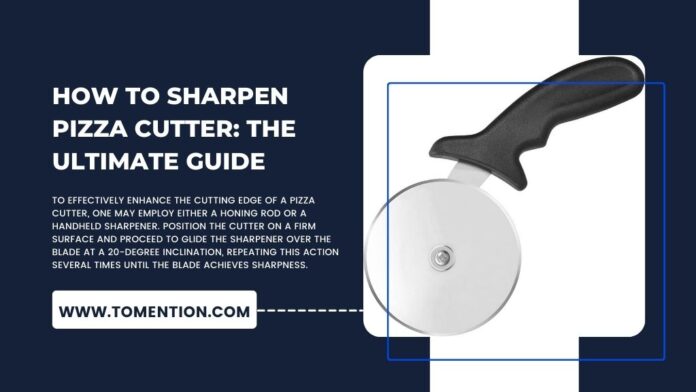How to sharpen pizza cutter? One may employ either a honing rod or a handheld sharpener. Position the cutter on a firm surface and proceed to glide the sharpener over the blade at a 20-degree inclination, repeating this action several times until the blade achieves sharpness.
Whether one is organizing a pizza night or managing a pizza establishment, possessing a well-honed pizza cutter is important in order to facilitate a seamless slicing endeavor. Over a prolonged period, the repeated utilization of the cutter might lead to the blunting of the blade, hence diminishing its effectiveness and inducing feelings of dissatisfaction.
Instead of opting for the replacement of a worn-out pizza cutter, it is possible to restore its cutting efficacy by employing a straightforward sharpening technique. In this discussion, we will examine a few uncomplicated techniques for restoring the functionality of your pizza cutter, guaranteeing consistently seamless and effortless slicing experiences. Now, let us get into the sequential procedure for honing a pizza cutter.
Why is sharpening your pizza cutter important?
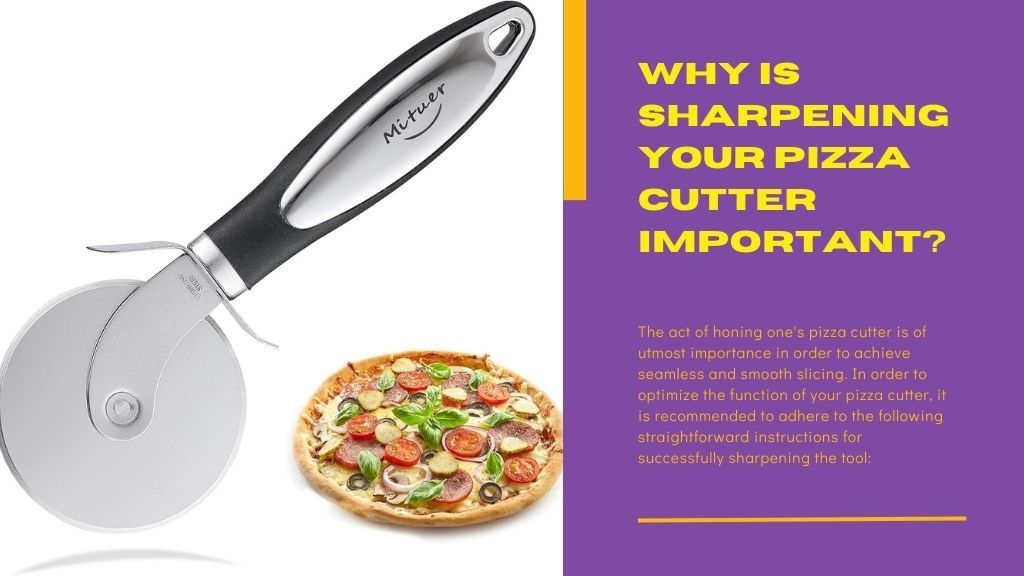
The act of honing one’s pizza cutter is of utmost importance in order to achieve seamless and smooth slicing. In order to optimize the function of your pizza cutter, it is recommended to adhere to the following straightforward instructions for successfully sharpening the tool:
A pizza enthusiast would find a sharp pizza cutter to be a necessary utensil. In addition to facilitating the process of cutting through one’s preferred pie with ease, this tool provides a variety of advantages that can augment the overall enjoyment derived from consuming pizza. This section will delve into the significance of honing one’s pizza cutter and the benefits it confers.
How to Cut a Pizza Without a Pizza Cutter
Make Your Pizza Cutter Last Longer
Sharpening your pizza cutter on a regular basis can dramatically increase its longevity. This is why:
- Efficient cutting: A sharp blade effortlessly slices through the crust, eliminating strain on the cutter’s handle. This results in a smoother and more efficient cutting operation that does not require excessive force.
- Prevent blade dulling: Consistent use of a pizza cutter can cause blade dulling over time. Sharpening the blade on a regular basis helps to keep it sharp and reduces the chance of generating jagged or uneven cuts.
- Avoid replacing the cutter: By keeping your pizza cutter sharp, you can avoid having to replace it as frequently. This not only saves you money but also assures you that you always have a dependable tool on hand for those tasty pizza nights.
Cuts that are cleaner and more precise
Sharpening your pizza cutter allows you to make cleaner, more exact cuts, resulting in a more enjoyable dining experience. This is why:
- Clean and exact slices: A sharp pizza cutter slides effortlessly through the crust, providing for clean and precise slices. This keeps the toppings from dragging or breaking since each piece is perfectly separated.
- Improved presentation: Clean cuts improve not just the overall aesthetic of your pizza but also make it more visually appealing. A sharp pizza cutter allows you to serve exactly portioned pieces, enhancing the appearance of your homemade or restaurant-style pizza.
- Consistent results: With a sharp blade, you may create uniform slices every time. This is especially crucial when sharing a pizza with guests or at a special event where presentation is important. Slice-size consistency promotes fairness and an even distribution of toppings for everyone to enjoy.
Sharpening your pizza cutter on a regular basis guarantees that every pizza-cutting experience is a breeze. It not only increases the cutter’s lifespan, but it also allows for cleaner, more precise cuts, bringing your pizza experience to a whole new level.
So grab your pizza cutter, sharpen it, and prepare to slice into your favorite pie with ease!
Different Pizza Cutter Styles
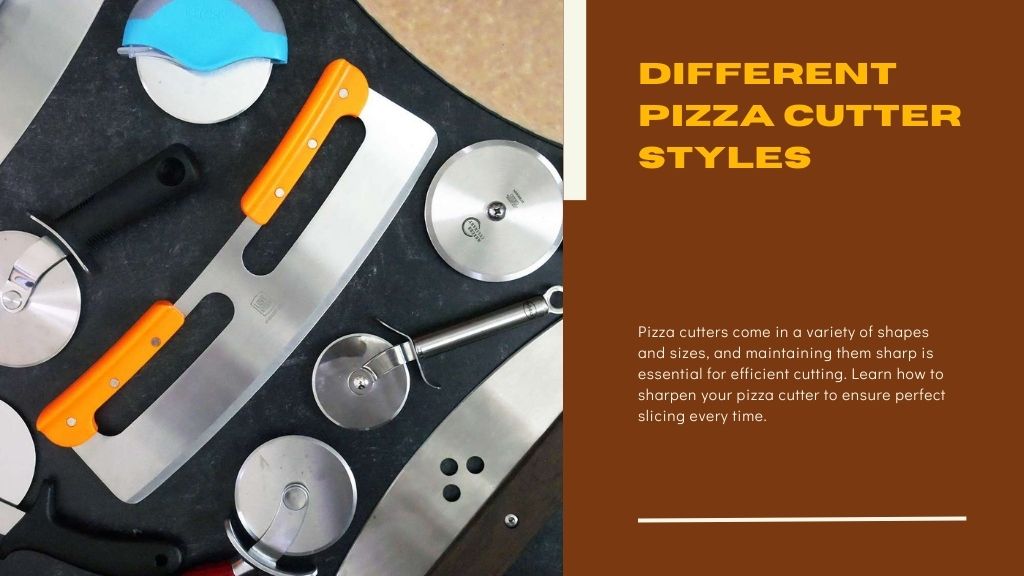
Pizza cutters come in a variety of shapes and sizes, and maintaining them sharp is essential for efficient cutting. Learn how to sharpen your pizza cutter to ensure perfect slicing every time.
Pizza cutters with a rotary blade:
- Rotary pizza cutters, which consist of a sharp circular blade attached to a handle, are the most common type of pizza cutter.
- These cutters are adaptable and can be used for a variety of activities, such as cutting dough or pastries.
- The circular blade glides effortlessly through the pizza, providing for rapid and easy slicing.
- To sharpen a rotary pizza cutter, perform the following steps:
- Begin by taking apart the cutter and detaching the blade from the handle.
- Sharpen the blade gently with a handheld knife sharpener or a sharpening stone, pushing it back and forth in a sweeping motion.
- Be careful not to apply too much pressure, since this could harm the blade.
- Reassemble the cutter after sharpening, making sure that the blade is securely attached to the handle.
- Check the cutter’s sharpness by slicing through a tomato or delicate fruit.
- Repeat the sharpening process as necessary until the desired sharpness is obtained.
Mezzaluna pizza cutters are a specialty.
- Mezzaluna pizza cutters are specialty knives with a crescent-shaped blade, sometimes known as rocking pizza cutters.
- The design allows for a simple back-and-forth rocking motion while the blade slices through the pizza.
- These cutters are appropriate for deep-dish or thick-crust pizzas.
- To sharpen a mezzaluna pizza cutter, do the following:
- To begin, place a damp towel on a chopping board for support.
- Sharpen the curved blade with a handheld knife sharpener or a sharpening stone while holding the mezzaluna cutter steady.
- Swipe the sharpener or stone along the blade’s edge in long, sweeping motions, ensuring equal pressure on both sides.
- Sharpen the blade until it is sharp and smooth.
- Before using the cutter, clean it by removing any metal shavings.
Pizza cutter with scissor blade:
- Scissor pizza cutters are a useful solution for individuals who prefer to slice pizzas with a scissor-like utensil.
- Two symmetrical blades joined by a hinge make up these cutters.
- Simply open the blades of a scissor pizza cutter and set them on the pizza crust to use.
- Apply uniform pressure to the blades as you slice through the pizza.
- To sharpen a scissor pizza cutter, perform the following steps:
- Unscrew the blades from the base, if possible, or follow the manufacturer’s instructions.
- Sharpen each blade individually using a handheld knife sharpener or a sharpening stone.
- Make sure the sharpener or stone follows the shape of the blade while retaining the original angle.
- After sharpening, carefully reattach the blades to the base.
- Sharpen the cutter by cutting through a piece of paper or thin cardboard.
Sharpening your pizza cutter allows for more efficient and simple slicing, resulting in perfectly cut pizza slices every time. Regular sharpening of rotary cutters, mezzaluna cutters, and scissor cutters will keep them functioning and increase their lives. Choose the method that works best for your cutter type, and you’ll have precise and pleasant pizza-cutting experiences.
Signs That Your Pizza Cutter Should Be Sharpened
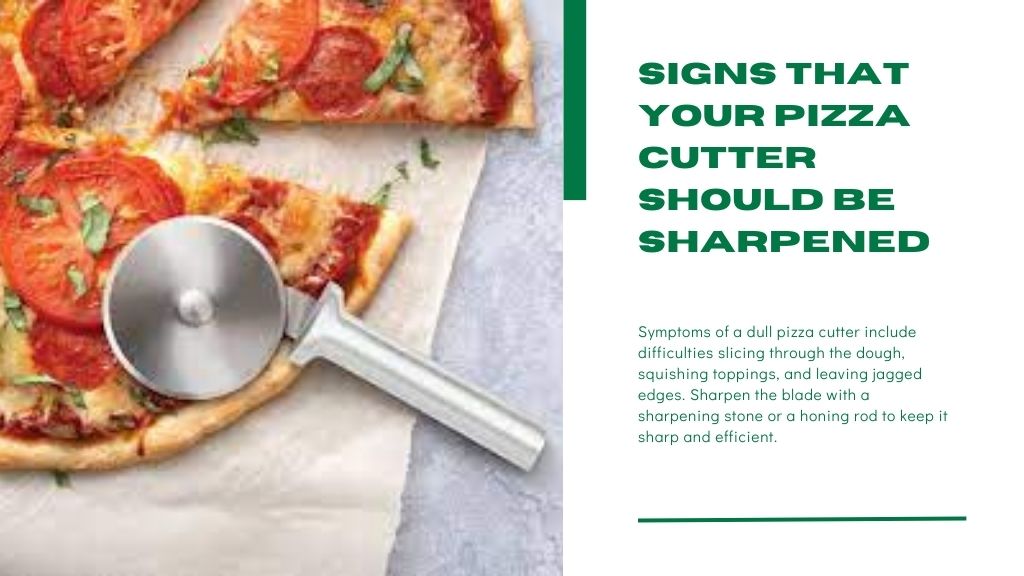
Symptoms of a dull pizza cutter include difficulties slicing through the dough, squishing toppings, and leaving jagged edges. Sharpen the blade with a sharpening stone or a honing rod to keep it sharp and efficient.
Are you sick of straining to cut your favorite pizza? It’s possible that the blade on your pizza cutter has worn down over time. To ensure a smooth cutting experience, be aware of the signals that your pizza cutter requires sharpening.
Here are some things to keep an eye out for:
- Dull blade: If you discover that the blade of your pizza cutter no longer has a sharp edge, it’s time to sharpen it. Cutting through the crust can be tough and time-consuming with a dull blade.
- Difficulties cutting through the crust: If your pizza cutter struggles to cut through the crust, leaving jagged edges or tearing at the dough, the blade needs to be sharpened. A sharp blade cuts through the crust with ease, resulting in clean and precise cuts.
- Uneven slices: If you routinely wind up with uneven slices of pizza, your pizza cutter has to be sharpened. A dull blade might cause the cutter to wander off course, resulting in varied thickness slices.
- Excessive pressure required: When your pizza cutter uses too much force to cut through the pizza, it’s a strong sign that the blade has become dull. A properly honed blade will require little pressure, allowing for easy and effective cutting.
- Tearing or dragging motion: If you experience tearing or dragging when using your pizza cutter, it means the blade is no longer sharp enough. A sharp knife will cut through the pizza without resistance or pulling.
- Reduced efficiency: A dull pizza cutter blade will lose its cutting effectiveness over time. If you’re spending more time and effort trying to cut through the pizza, it’s a sign that the blade needs to be sharpened.
By paying attention to these indicators, you can ensure that your pizza cutter is always in top shape and ready to provide perfectly sliced pizzas with ease. Remember that a well-sharpened pizza cutter not only improves your cutting experience but also ensures that your favorite meal is presented visually appealingly.
Sharpening Equipment and Materials
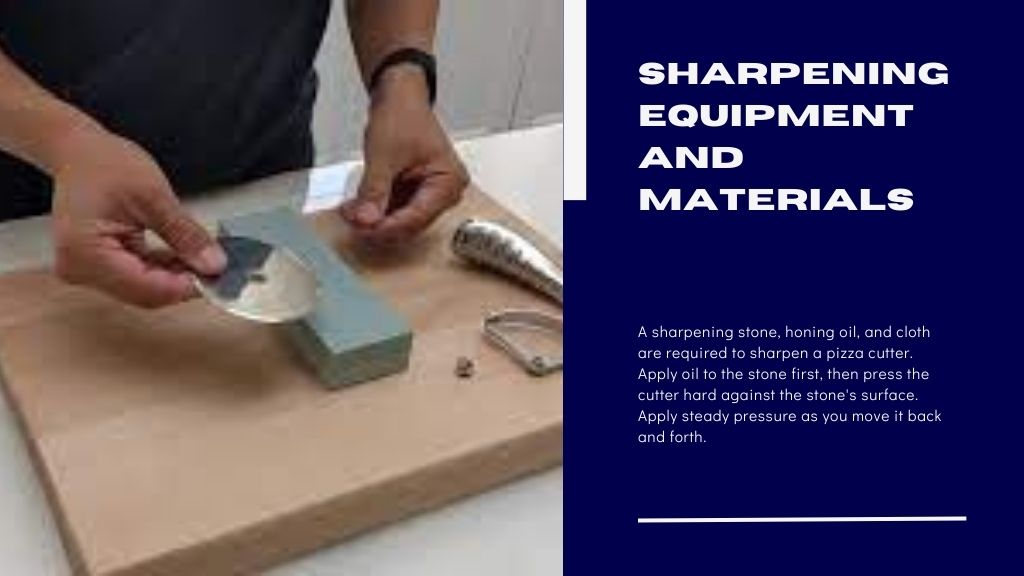
A sharpening stone, honing oil, and cloth are required to sharpen a pizza cutter. Apply oil to the stone first, then press the cutter hard against the stone’s surface. Apply steady pressure as you move it back and forth.
Finally, using the cloth to clean the cutter, you’re ready to slice through pizza with ease.
You’ll need a few basic pieces of equipment and materials to get started if you want to keep your pizza cutter in good condition. Here are the tools you’ll need to correctly sharpen your pizza cutter:
- Sharpening stone: A sharpening stone is an essential item for restoring the cutting edge of your pizza cutter. To achieve a smooth and exact sharpening process, use a stone with fine grit.
- Honing oil: Honing oil is required for maximum outcomes. This lubricant reduces friction between the sharpening stone and the blade, making the sharpening process more efficient and effective.
- Cloth or towel: Always keep a cloth or towel on hand. This will be used to clean both the pizza cutter and the sharpening stone, keeping both clean and free of dirt that could interfere with the sharpening process.
With these tools and materials on hand, you’ll be well-equipped to sharpen your pizza cutter and ensure smooth, simple cutting every time. So let’s get started and learn how to sharpen a pizza cutter like a pro!
Sharpening Your Pizza Cutter Step-by-Step
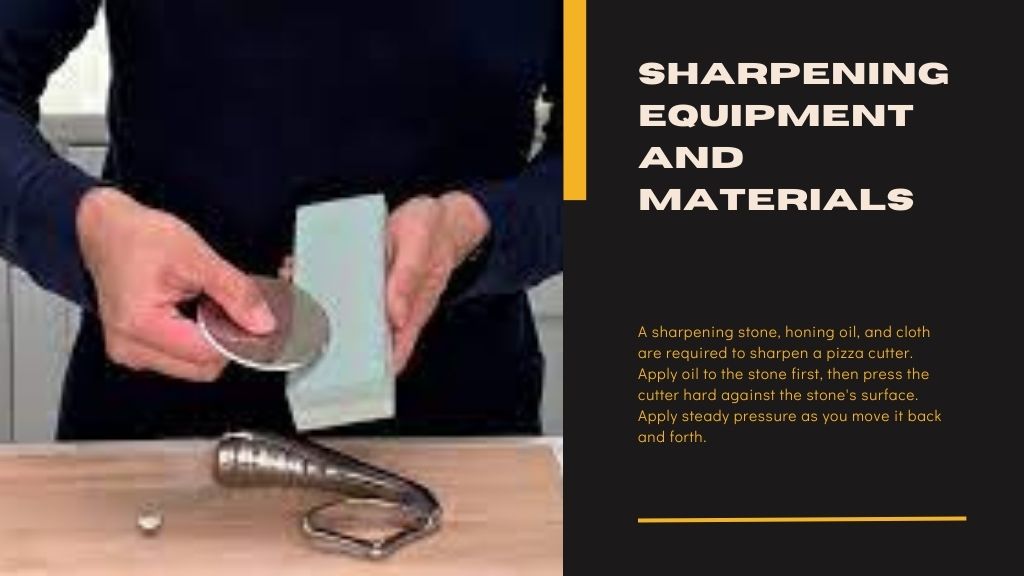
This step-by-step guide will show you how to sharpen your pizza cutter. Keep your cutter in good working order for effortless slicing and precise slices with every bite.
If you’re weary of struggling to cut through your pizza or discovering that your pizza cutter isn’t as sharp as it once was, it’s time to sharpen it. Sharpening your pizza cutter is a simple step that can restore its slicing strength and simplify pizza nights.
Follow this step-by-step process for sharpening your pizza cutter, and you’ll always have properly cut pieces.
Remove the cutter.
Before you begin sharpening your pizza cutter, properly clean it to eliminate any debris or food particles. Clean both sides of the cutter wheel with warm, soapy water and a scrub brush. Before proceeding to the next step, carefully rinse and dry it.
Sharpening Stone Preparation:
A sharpening stone is required to sharpen your pizza cutter. Check that it is clean and free of residue. Place the sharpening stone on a flat surface, such as a cutting board or countertop, and ensure that it is solid and will not move during the sharpening process.
Use Honing Oil:
A few drops of honing oil should be applied to the sharpening stone. This lubricates the stone and facilitates honing. Apply a little layer of oil to the stone’s surface, distributing it evenly.
Maintain the correct angle with the cutter.
Maintain a firm grip on the pizza cutter with your dominant hand, the wheel facing away from you. Sharpen the cutter wheel at a 20- to 30-degree angle on the sharpening stone. This angle allows the blade to make efficient contact with the stone while limiting the danger of harm.
Start sharpening:
Glide the pizza cutter back and forth over the sharpening stone with little pressure. Begin at the base of the blade and work your way to the tip. Maintain a steady pace and keep the blade in contact with the stone to ensure even sharpening of the whole blade.
Repeat this motion 10 to 15 times.
Examine the sharpness.
It is critical to examine the sharpness of your pizza cutter after sharpening. Touch the blade’s edge with your fingertip, providing little pressure. If the blade feels sharp and cuts through the skin smoothly and without resistance, your pizza cutter is ready to use.
If not, sharpen for a few more strokes and try again.
By following these simple procedures, you can keep your pizza cutter sharp and ensure that each slice is correctly sliced. Sharpening your pizza cutter on a regular basis can not only make your slicing jobs easier, but it will also extend the life of your cutter.
So, roll up your sleeves, grab your sharpening stone, and enjoy the convenience of hassle-free pizza slicing!
Sharpening Pizza Cutters in Different Ways
Learn how to sharpen your pizza cutter in a variety of ways for a precise, effortless slice. You may restore the blade’s sharpness and efficiency using experienced tips and procedures, delivering a precise cut every time.
If your pizza cutter isn’t cutting through your favorite slices as smoothly as it once did, it’s time to sharpen it. Fortunately, there are a few alternative methods you may try to restore the sharpness of your pizza cutter and get it back to effortlessly slicing through pizzas.
Let’s look at two useful methods: utilizing a whetstone and using a honing rod.
Making Use of a Whetstone:
- Wet the whetstone: Soak the whetstone in water for about 10 minutes before beginning to sharpen your pizza cutter.
- Set up the whetstone: Set up the whetstone in a firm place so it doesn’t slip throughout the sharpening process.
- Angle the cutter: Hold the pizza cutter at a 20-degree angle against the coarse side of the whetstone.
- Sharpen gradually: side. by gently sliding the cutter back and forth on the whetstone. With each stroke, make sure to cover the entire blade. This motion should be repeated 10 to 15 times.
- Change to the fine side. When you’re finished with the coarse side, flip the whetstone to the fine side. Repeat the sharpening operation, sliding the cutter back and forth about 10 to 15 times.
- Clean and dry: After sharpening, properly clean the cutter and dry it before using it again.
Honing with a rod:
- Grip the rod firmly. Ensure a strong grip on the honing rod.
- Hold the pizza cutter with the blade pointing away from you and rest it on the honing rod.
- Honing angle: Hold the cutter at a 20-degree angle against the honing rod.
- Honing motion: Swipe the cutter back and forth along the length of the honing rod with mild and controlled pressure. This motion should be repeated 10 to 15 times.
- Alternate sides: For even honing, swap the cutter position and repeat the process on the opposing side.
- Rinse and dry: After honing, rinse the cutter to remove any metal shavings and fully dry it before using it again.
You can ensure that your pizza cutter preserves its cutting edge and continues to offer you clean, simple pizza slices by using these different ways of sharpening it. Whether you prefer a whetstone or a honing rod, both approaches may efficiently maintain the sharpness of your pizza cutter and improve your pizza-slicing experience.
Techniques for Keeping a Sharp Pizza Cutter
With these helpful tips and tactics, maintaining a sharp pizza cutter is a breeze. Learn how to sharpen your pizza cutter quickly and efficiently to ensure perfect slicing every time.
When it comes to slicing through your favorite homemade or delivered pizza, a well-maintained pizza cutter can make all the difference. Whether you’re a pizza connoisseur or a novice, understanding how to sharpen your pizza cutter is vital for simple slicing.
Use these simple techniques and tactics to keep your pizza cutter sharp and glide through your pizza like a hot knife through butter.
Clean Your Cutter on a Regular Basis:
1. Clean after each use: After slicing your pizza, clean your cutter to avoid any residual cheese or sauce from sticking to the blade. This will help to keep the cutter operational and avoid corrosion.
2. Use warm, soapy water: Fill a sink or basin halfway with warm water and a few drops of dish soap. Allow the cutter to soak for a few minutes to release any food particles before carefully scrubbing the blade and handle with a soft cloth or sponge. Thoroughly rinse and pat dry.
3. Check to see if your pizza cutter is dishwasher-safe before cleaning it. Some cutters have wooden or plastic handles that might warp in the dishwasher.
4. Avoid entirely submerging the cutter: If your cutter has a wooden or plastic handle, avoid completely submerging it in water, since this can cause harm. Instead, use a moist towel to wipe away any debris or residue from the handle.
To avoid damage, store it properly.
- Locate an appropriate storage location. When not in use, it is critical to properly store your pizza cutter to prevent it from becoming dull or broken. Choose a location in your kitchen that is both conveniently accessible and secure.
- Use a protective cover. If your pizza cutter does not come with one, consider purchasing one. A cover will not only protect the blade from accidental cuts but will also keep it from becoming dull or nicked when stored with other utensils.
- Hang it up: If your drawer space is limited, consider hanging your pizza cutter on a hook or magnetic strip. This not only keeps it conveniently available but also avoids the possibility of it becoming damaged or dull due to being jostled around in a busy drawer.
- Keep it away from moisture and heat. Avoid storing your pizza cutter near moisture or heat sources. Moisture and heat can cause the blade to corrode or be damaged, diminishing its sharpness and efficacy.
You can ensure that slicing your favorite slices is a breeze by following these simple tips and tactics for maintaining a sharp pizza cutter. To avoid damage, remember to clean your cutter after each use and store it carefully.
With a well-maintained pizza cutter, you’ll always be able to enjoy perfectly sliced pizza.
Is it possible to sharpen a serrated pizza cutter blade?
Yes, you can sharpen a serrated pizza cutter blade, but only with the right tools and skills. Here’s what you should know:
- Sharpen the grooves of a serrated blade with a tapered round file: This tool was specifically developed for this purpose.
- Make sure the file size corresponds to the serration frequency: Make sure the file size corresponds to the size of the serration grooves.
- Sharpen at the proper angle: holding the file perpendicular to the blade, sharpen each groove separately.
- File in one direction only: Move the file back and forth in one direction only, following the serration angle.
- Maintain equal strokes: To guarantee even sharpness, use the same number of strokes on each individual groove.
Remember, whether your pizza cutter is serrated or not, regular maintenance and correct sharpening will improve its lifespan and cutting efficacy. Have fun slicing!
Frequently Asked Questions: How to Sharpen Pizza Cutter
What Is the Best Way to Sharpen a Straight Cutter?
- To sharpen a straight cutter, perform the following steps:
- Begin by properly cleaning the cutter.
- To maintain a consistent angle, use a sharpening stone or a honing guide.
- Begin sharpening by applying even pressure to the cutter and moving it in a steady motion.
- After sharpening, use a scrap piece to test the cutter’s efficacy.
What Is the Best Way to Sharpen a Rada Pizza Cutter?
Use a sharpening stone or knife sharpener to sharpen a Rada pizza cutter. Sharpen the blade by swiping it back and forth on the sharpening tool at the proper angle.
Do pizza wheels wear out?
Yes, pizza wheels can become dull with repeated use.
What Is the Best Way to Sharpen a Rocker Blade?
Follow these steps to sharpen a rocker blade: 1. Place the blade in a vice to keep it stable. 2. File the edges at a 45-degree angle using a flat file or sharpening stone. 3. Sharpen both sides of the blade, making sure they are even and consistent.
4. After sharpening, use a honing stone or emery cloth to remove any burrs. 5. Run your fingertips over the edges of the blade to test its sharpness (be careful!). 6. Finally, return the blade to your equipment and double-check its security before using it.
How Often Do I Need to Sharpen My Pizza Cutter?
Sharpen your pizza cutter at least once a month to keep it slicing efficiently.
Conclusion
Maintaining the sharpness of your pizza cutter guarantees that you can effortlessly slice through each delectable pie you make. You can keep your pizza cutter in good condition by following the methods indicated in this blog post. Begin by acquiring the necessary ingredients, which include a sharpening stone and vegetable oil.
Then, sharpen your pizza cutter with care, keeping a steady angle and exerting even pressure. Remember to completely clean the cutter after sharpening, eliminating any metal shavings or debris. Regularly sharpening the blade and caring for your pizza cutter will increase its lifespan and make pizza-making more fun.
So, the next time you reach for the pizza cutter, you can be assured that it will glide effortlessly through the dough, ensuring excellent slices every time. Happy slicing!

